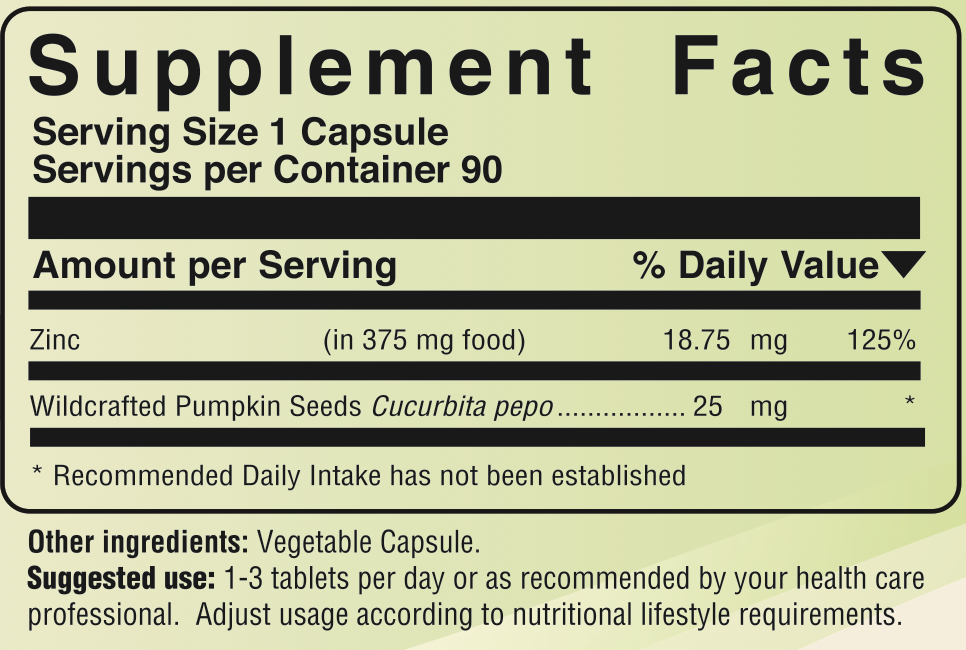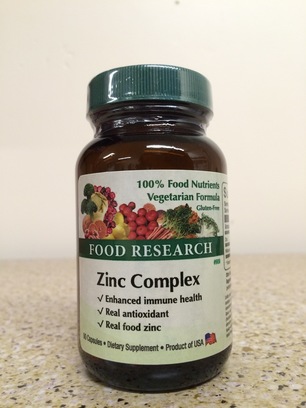
90 Tablets $19.98
Vegetarian Formula * Dietary Supplement
 |
||
|
||
Food Zinc Complex is an excellent 100% Food source of organic zinc. Most researchers acknowledge that organic zinc is better absorbed than inorganic zinc [1]. Zinc itself is generally found in the human body attached to a peptide [1,2]; it is often attached with albumin [1,2] or alpha2-macroglobulin [1] or exists as part of one of the many zinc metalloenzymes [1,2]. Zinc, as found Food Zinc Complex, is in a complex matrix of peptides, carbohydrates and lipids. Zinc is not naturally found in the body as zinc citrate, zinc chloride, zinc picolinate, etc. Zinc deficiency in humans can cause alopecia, impotence, skin problems, immune deficiencies, increased susceptibility to infection/sore throats, night blindness, impaired taste, delayed wound healing, impaired appetite, photophobia (hypersensitivity to light), difficulty in dark adaptation, growth retardation, male infertility (low sperm counts), liver enlargement, and spleen enlargement [1,2].
Nutritional yeast is an excellent source of zinc because, “fermenting organisms produce phytases that break down phytate and increase the amount of absorbable zinc” [3]. Nutritional yeast also contains certain amino acids [4] that enhance the absorption of zinc [3]. Since diabetics seem to need zinc, but there deficiencies are refractory to zinc salts [5], food forms of zinc should also be a better choice for absorption for this population.
Electron microscopy reveals that USP zinc compounds (the most common form in supplements) have a crystalline appearance whereas Food Zinc Complex has more of a rounded appearance (see below). Food Zinc Complex also appears to be smaller than USP zinc compounds (see below). Nutrition scientists understand that smaller particle size improves bioavailability (the main point of digestion is to create food particles small enough to be absorbed by intestinal villi) [1,6].
Is Your Form of Zinc Food or an Industrial Chemical?
| Zinc Form | Actually Is / Commonly Used As | |
| Food Zinc | Zinc naturally complexed within a plant or other food/ used only as a food. | |
| Zinc Acetate | A mineral salt (rock) made from zinc nitrate and acetic anhydride/ induces vomiting [8]. | |
| Zinc Carbonate | Rock known as smithsonite or zincspar/ used to manufacture rubber [8]. | |
| Zinc Chloride | A mineral salt (rock) consisting of zinc and chloride/ an embalming material [8]. | |
| Zinc Citrate | Rock (smithsonite) processed with citric acid/ used in manufacture of some toothpaste[8]. | |
| Zinc Gluconate | Rock processed with gluconic acid/ gluconic acid is used in many cleaning compounds [8]. | |
| Zinc Lactate | Rock (smithsonite) processed with lactic acid/ lactic acid lactate is used as a solvent [8]. | |
| Zinc Orotate | Rock processed with orotic acid/ orotic acid is a uricosuric (promotes uric acid excretion) [8]. | |
| Zinc Oxide | Rock known as zincite/ used as a pigment for white paint and as part of quick-drying cement [8]. | |
| Zinc Phosphate | Rock known as hopeite/ used in dental cements[8]. | |
| Zinc Picolinate | Rock processed with picolinic acid [9]/ Picolinic acid is used in some herbicides. | |
| Zinc Sulfate | Not absorbed as well as food zinc [3,9]/ used as a corrosive in calico-printing; preserves wood [8]. |
The addition of “citric acid and picolinic acid do not appear to enhance zinc absorption” [9]. Plants have roots or hyphae which aid in the absorption of minerals. Plants actually have the ability to decrease the toxicity of compounds by changing their biochemical forms [10]. Plants are intended to ingest rocks, humans are not.
“The commonest means of inducing zinc deficiency in the rat is to feed it a semisynthetic diet” [2]. With today’s semi-synthetic refined and genetically-modified foods, probably all of your clients could benefit from 100% Food Zinc Complex. Since “In humans, zinc deficiency does not usually occur in the absence of some degree of protein depletion” [2], does it make sense to supplement with an isolated mineral salt? All the of the essential amino acids (arginine, histidine, isoleucine, leucine, lysine, methionine, phenylalanine, threonine, tryptophan, and valine [1]) naturally occur in Food Zinc Complex (plus other amino acids including alanine, aspartic acid, cysteine, glutamic acid, glycine, proline, serine, and tyrosine. Amino acids are necessary for the production of most of the tissues in the body [1,6].
Interestingly in 1999, the Nobel prize in medicine was awarded for the finding that humans need protein chaperones in order for minerals like zinc to be absorbed into the cell. Zinc mineral salts do not contain protein chaperones, yet 100% Food Zinc Complex naturally contains protein chaperones such as ceruloplasmin and ATX1 [11,12].
“Superoxide dismutase (S.O.D.) is one of the most important enzymes that function as cellular antioxidants...The absence of this enzyme is lethal” [1]. “It protects intracellular components from oxidative damage, converting the superoxide ion to hydrogen peroxide” [1]. S.O.D. appears to be able to prevent activation of “phospholipase A2 and proanoid synthesis by scavenging free radicals, thereby reducing lipid peroxidation products” [13]. It is a powerful free radical scavenger which has been clinically shown to protect the brain, heart, liver, lungs, kidneys, skin, muscles, penis, nerves, and spinal cord from ischemic injury [9]. S.O.D. has been shown to inhibit articular tissue damage associated with osteoarthritis, decreases lipid peroxidation in damaged skin cells, protect against late radiation-induced tissue injury, improves clinical symptoms associated with Bechet’s syndrome, helps protect the retina, helps protect against iron toxicity, inhibits vasogenic brain edema after brain injury, increases flu survival rates in mice, plays a role in bacterial defense, helps normalize blood pressure, helpful for cardiovascular problems, reduces LDL oxidation involved in atherosclerosis, is reduced in Alzheimer’s patients, improves sperm motility, and even helped patients with TMJ who did not respond to traditional therapy [14]. High levels of S.O.D. have been associated with reduced growth of Candida albicans [15]. S.O.D. is often sold in a “purified” version (from animal products) as an antiaging product [6]; S.O.D. seems to have “antiaging” properties [14]. Ingestion of polyethylene glycol-conjugated superoxide dismutase (an isolated form) is not as effective as Food CuZn (copper/zinc) superoxide dismutase [16-17]. CuZn superoxide dismutase, along with Mn superoxide dismutase [18], exists naturally, in vegetarian 100% Food, Zinc Complex.
Rice bran is another Food source of zinc, silicon, and B vitamins [6,19], while kelp is an excellent Food source of trace minerals [20]--both are found in Food Zinc Complex.
Since Food Zinc Complex is a Food and not an industrial mineral salt, 100% Food Zinc Complex is the scientifically preferred source of zinc supplementation, whether for long-term or short-term use.

Contains
naturally occurring carbohydrates, lipids, proteins (including all ten
essential amino acids), superoxide dismutase, and truly organic
bioflavonoids as found in enzymatically processed Saccharomyces
cervisiae and organic pumpkin seeds Cucurbita pepo all the nutrients shown above are contained in these foods. Unlike many so-called "natural" zinc formulas, this Zinc Complex
is a food zinc (not a mineral salt) contains no synthetic USP nutrients
or mineral salts, but only contains foods, food complexes, and food
concentrates.
Numerous university
studies have concluded that supplements containing food nutrients are
better than USP isolates. Food nutrients are better because they
contain important enzymes, peptides, and phytonutrients CRITICAL to the
UTILIZATION of vitamins and minerals which are not present in isolated
USP nutrients. Published research has concluded that food vitamins are
superior synthetic/USP vitamins.
Suggested use: 1-3 tablets per day or as recommended by your health care professional. Adjust usage according to nutritional lifestyle requirements.
 Zinc Complex Video
Zinc Complex Video
References
[1] Shils ME, Olson JA, Shike M. Modern Nutrition in Health and Disease, 8th ed. Lea & Febiger, Phil.,1994
[2] Cunnane SC. Zinc: Clinical and Biochemical Significance. CRC Press, Boca Raton (FL),1988
[3] Shils ME, et al. Modern Nutrition in Health and Disease, 10th ed. Lippincott Williams & Wilkins, Balt., 2006:273
[4] Leavening agents, yeast, baker's, compressed. USDA National Nutrient Database for Standard Reference, Release 18 (2005)
[5] Cunningham JJ. Micronutrients as nutriceutical interventions in diabetes mellitus. J Am Coll Nutr. 1998;17(1):7-10
[6] Whitney EN, Hamilton EMN. Understanding Nutrition, 4th ed. West Publishing, NY, 1987
[7] Turner G. Spectral Data Services. Tests conducted February 1993
[8] Budavari, S editor. The Merck Index, 12th ed. Merck & Co., Rahway (NJ), 1997
[9] King JC, Keen CL. Zinc. In Modern Nutrition in Health and Disease, 9th ed. Williams & Wilkins, Balt., 1999:223-239
[10] Huang Y, Chen Y, Tao S. Effect of rhizospheric environment of VA-mycorrhizal plants on forms of Cu, Zn, PB and Cd in polluted soil. Ying Yong Sheng Tai Xye Bao 2000;11(3):431-434
[11] Rouhi AM. Escorting metal ions: protein chaperone protects, guides, copper ions in transit. Chem Eng News, 1999;11:34-35
[12] Himelblau E, et al. Identification of a functional homolog of the yeast copper homeostasis gene ATX1 from Arabidopsis. Plant Physiol 1998;117(4):1227-1234
[13] Targarona EM, et al. Transplantation Proceedings,1992;24(1):9-10
[14] Null G. Superoxide Dismutase. In The Clinician’s Handbook of Natural Healing. Kensington Books, New York, 1997:137-144
[15] Romandini P, Bonotto C, Bertoloni G, Beltramini M, Salvato B. Superoxide dismutase, catalase and cell dimorphism in Candida albicans cells exposed to methanol and different temperature. Comp Biochem Physiol Pharm Toxicol Endocrinol,1994;108(1):53-57
[16] Haun SE, Kirsch JR, Helfaer MA, Kubos KL, Traystman RJ. Polyethylene glycol-conjugated superoxide dismutase fails to augment brain superoxide dismutase activity in piglets. Stroke,1991;22(5):655-659
[17] Tibell L, Aasa R, Marklund SL. Spectral and physical properties of human extracellular superoxide dismutase: a comparison with CuZn superoxide dismutase. Arch Biochem Biophys, 1993;304(2):429-433
[18] Turi TG, Kalb VF, Loper JC. Cytochrome P450 lanosterol 14 alpha-demethylase (ERG11) and manganese superoxide dismutase (SOD1) are adjacent genes in Saccharomyces cerevisiae. Yeast,1991;7(6):627-630
[19] Jensen B. The Chemistry of Man. Bernard Jensen, Escondido, 1983
[20] Seaweed, kelp, raw. USDA Nutrient Database for Standard Reference, Release 11-1, August 1997
Some of these studies (or citations) may not conform to peer review standards (though most do). Therefore, the results are not conclusive. Professionals can, and often do, come to different conclusions when reviewing scientific data. None of these statements have been reviewed by the FDA. All products distributed by Doctors’ Research, Inc. are nutritional and are not intended for the treatment or prevention of any medical condition.